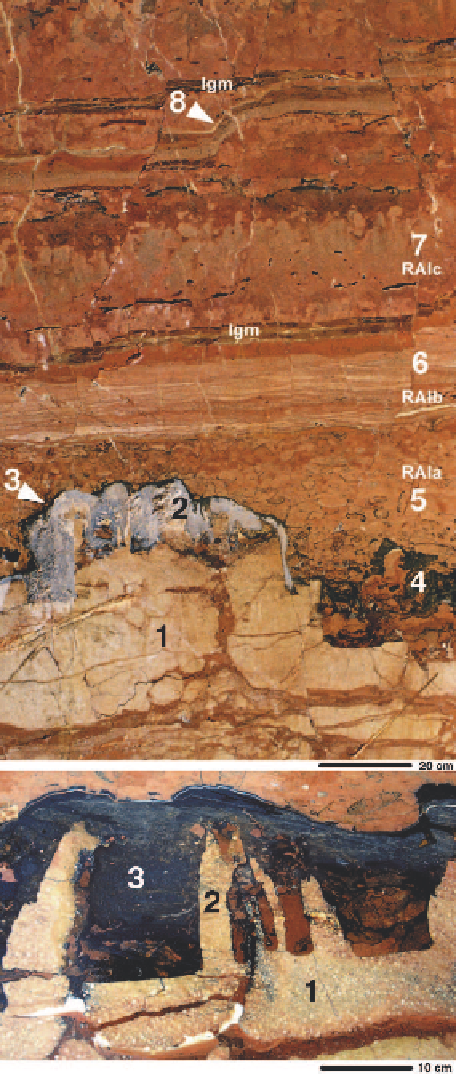Geology Reference
In-Depth Information
Fig. 5.11.
Submarine condensation and lost or hidden time
record.
The upper figure shows a wire-cut section of a se-
quence of strongly condensed Liassic and Middle Jurassic
limestones in western Sicily.
A distinct marine hardground horizon (2) occurs at the
top of Carixian-Domerian crinoidal packstones (1). The crin-
oidal sand was deposited on a stepped escarpment. The hard-
ground (shown in detail in the lower figure) forms a distinct
paleorelief and is characterized by a distinct erosional sur-
face, covered by a dark crust (3) of variable thickness. The
crust consists of manganese oxides, goethite and calcite. The
origin of the hardground is interpreted as result of dissolu-
tion related to the widespread early Toarcian anoxic event in
the Tethyan Sea.
The overlying limestone succession represents the typi-
cal Ammonitico Rosso facies of the Mediterranean region
(see
Pl.
139).
The succession consists of several units differing in tex-
ture, microfacies and biostratigraphical age: Fillings of de-
pressions at the top of the hardground (4) yield bio/lithoclas-
tic wackestones with reworked Fe/Mn crusts. The overlying
Rosso Ammonitico Inferiore unit (RAI) consists of red nodu-
lar cephalopod limestones (RAIa, 5), pink wavy cross-bed-
ded limestones (RAIb, 6) and red pseudonodular limestones
(RAIc, 7). Note the current ripple structure of unit RAIb in-
dicating episodic deposition of bioclastic sands with pelagic
bivalve shells (
Bositra
) from shifting currents of micro-
turbidites on the otherwise starved sediment surface. Unit
RAIc is strongly bioturbated and contains small-scale Fe-
Mn coated condensation surfaces as well as laminated goeth-
itic Fe-Mn rich marls (lgm) exhibiting signs of early defor-
mation (8) subsequent to compaction.
Ammonites found in the limestones of the units permit
the recognition of various biozones which indicate the exist-
ence of the Toarcian (2, 3), Bajocian (4), Bathonian (6) and
Callovian (7).
Some of the missing biozones are known from other
nearby localities, but some biozones could not be verified.
The time represented by these biozones may be hidden in the
condensation horizons, but just imagine, the total duration
of the end-Torcian to middle Callovian time ranges is about
20 million of years! Modified from Di Stefano et al. (2002).
Assuming a comparable growth rate of goethite
crusts and modern deep-sea manganese nodules, a
timespan of about 9.5 million years is estimated for
the duration of the discontinuity events.
Different growth rates (60 mm/10
3
and 200 mm/
10
3
years) were estimated for Fe/Mn crusts on Jurassic
hardgrounds using sessile foraminifera growing upon
ferruginous laminae (Wendt 1970).
A time range between 25 000 and 125 000 years
was estimated for the duration of the breaks associated
with the formation of Ordovician hardground of the
Scandinavian-Baltic shelf (Lindström 1979).
5.2.5 Discontinuities and Sequence
Stratigraphy
Unconformities and condensed sections are essential
for the identifying depositional sequences and their
boundaries. The observation and interpretation of
small-scale discontinuities assist in high-resolution se-
quence analysis, of shelf carbonates (Krawinkel and
Seyfried 1996) and pelagic carbonates (Martire 1992).

